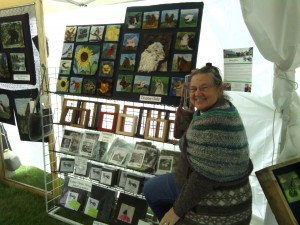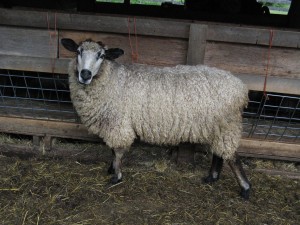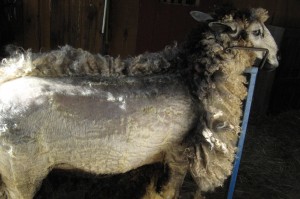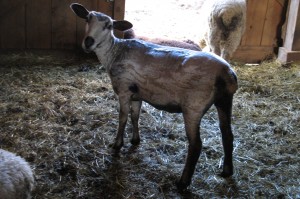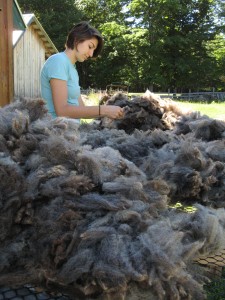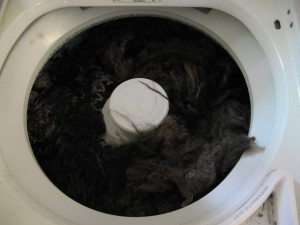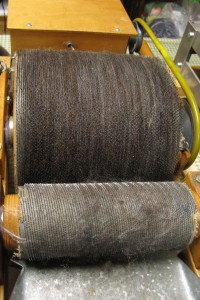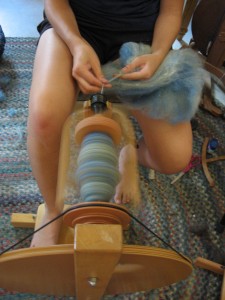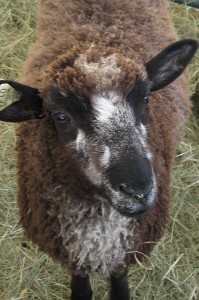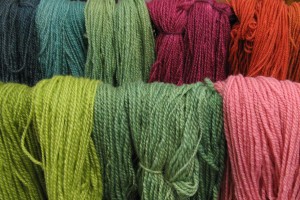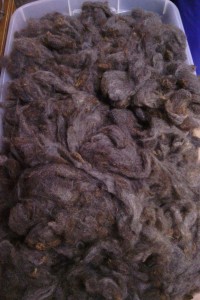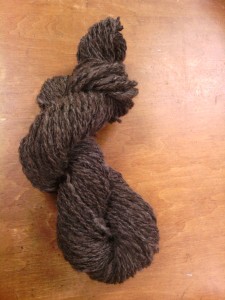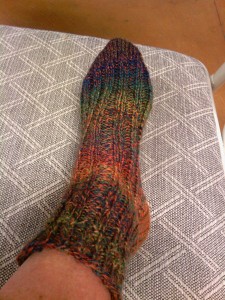My eleventh farm was A Wrinkle in Thyme Farm in Sumner, Maine.
The Farm
The farmers are Marty and Mary Ann. Marty is originally from Maine and wanted to come back after living in the Midwest. They bought thirty-two acres in Sumner, Maine in 1995. Their property had a lot of grass so they asked a neighbor if they could borrow his lawnmower. Instead of lending his lawnmower, the neighbor offered some sheep to clip the grass. Marty and Mary Ann took a small number of the sheep, not planning to get any more. But one of the sheep was pregnant and from that a fiber farm was born. They now have a small flock of about forty sheep. The fleeces are processed into wool for needle felting, spinning and knitting. Marty is a needle-felting artist. She teaches classes in fiber arts and hosts drop-in knitting sessions at the farm. They named their farm after the children’s book A Wrinkle in Time because they do things the old fashioned way, time traveling as in the book. They have a border collie named Meg after the main character in the story, and a cat named Whatsit after one of the witches. The building they use for fiber arts is called the Tesseract which is the device used in the book to time travel. When I first heard them call the building the Tesseract, I assumed it was a Maine expression for that particular type of building.
My Farming Experience
A year ago I never would have thought I’d be volunteering on a sheep farm learning to spin wool and knit. However, after volunteering on goat dairies and vegetable farms, I decided I wanted a completely new experience. I’d also taken up knitting last November after I’d met a WWOOFer who knit and then gotten a hole in one of my wool socks. Since I’m into Do It Yourself, I figured I’d knit a new pair of socks. My mom taught me to knit when I was a young teenager and I was trying out different needle crafts–embroidery, rug hooking, cross-stitch. Before embarking on socks, I knit a practice hat and found that the muscle memory for knitting had only been dormant. I’d work with the needles to make a purl stitch and during the struggle suddenly think ‘This feels right,’ and sure enough, I’d pull the needle through and have made a purl stitch. With the help of YouTube sock-knitting tutorials, determination and patience I successfully knit a perfectly wearable pair of wool socks. (and quickly got a hole in one of them). In the process of knitting them, I had lots of strange things happen: suddenly I’d have one too many stitches on a needle; later I’d have one too few stitches on another needle; strange loops would be hanging in the middle of my socks; thick blobs of wool kept appearing on the last stitch on a needle. I needed help with my knitting. On A Wrinkle in Thyme Farm, I’d not only get to meet sheep for the first time, but I’d also get answers to the mysterious things that were happening with my knitting.
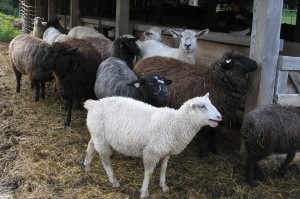 The lambs were my introduction to the farm. There were six that had been born in the spring who still needed a bit of grain to supplement the grass they ate in the pasture. Morning and evening chores involved rattling grain in a bucket and watching them bound towards me with their ears flapping and squeeze through a narrow opening in a door to get inside the creep where their grain dishes were. The adult ewes milled about, some of them hopeful that they could fit into the creep and get some of the grain for themselves. Others, like the friendly Beatriz, just wanted a nice rub on the head. Many of the ewes were big and fluffy; they looked just like a squiggly outline drawing of a fat sheep. That would soon change.
The lambs were my introduction to the farm. There were six that had been born in the spring who still needed a bit of grain to supplement the grass they ate in the pasture. Morning and evening chores involved rattling grain in a bucket and watching them bound towards me with their ears flapping and squeeze through a narrow opening in a door to get inside the creep where their grain dishes were. The adult ewes milled about, some of them hopeful that they could fit into the creep and get some of the grain for themselves. Others, like the friendly Beatriz, just wanted a nice rub on the head. Many of the ewes were big and fluffy; they looked just like a squiggly outline drawing of a fat sheep. That would soon change.
The main product of A Wrinkle in Thyme Farm is needle-felting kits. Needle felting is making pictures using a special 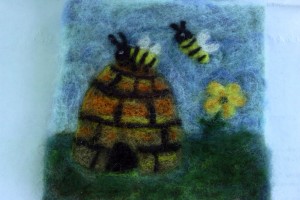 needle to poke wool into a felt or cloth backing. For the artistically challenged like me it’s a good medium because it’s easy and you can pull out anything you don’t like and try again. The weekend after I arrived, we went to the Bethel Arts Fair. The WWOOFer job was to demonstrate needle felting. Neither of us had done it before. The other WWOOFer Abbie, who is not in the least artistically challenged, needle felted from a photo she had of her cat. I chose a kit that featured honey bees on a hive. It had a hand drawn outline of the picture and the balls of wool I’d need. It is kind of like needle felting by number–foolproof. People stopped by and Abbie explained what we were doing. I was concentrating too hard to look up. It only takes a few hours to make a needle-felted picture and I was soon adding finishing touches to my bees. “Wow,” I thought. “It turned out nice.” The bees had a 3-D look next to the flatter hives. Women would watch us work and remark on how lovely our work was, but that they could never do it. “If I can do it, you can do it!” I’d quickly respond. Some of them believed me and bought kits for themselves.
needle to poke wool into a felt or cloth backing. For the artistically challenged like me it’s a good medium because it’s easy and you can pull out anything you don’t like and try again. The weekend after I arrived, we went to the Bethel Arts Fair. The WWOOFer job was to demonstrate needle felting. Neither of us had done it before. The other WWOOFer Abbie, who is not in the least artistically challenged, needle felted from a photo she had of her cat. I chose a kit that featured honey bees on a hive. It had a hand drawn outline of the picture and the balls of wool I’d need. It is kind of like needle felting by number–foolproof. People stopped by and Abbie explained what we were doing. I was concentrating too hard to look up. It only takes a few hours to make a needle-felted picture and I was soon adding finishing touches to my bees. “Wow,” I thought. “It turned out nice.” The bees had a 3-D look next to the flatter hives. Women would watch us work and remark on how lovely our work was, but that they could never do it. “If I can do it, you can do it!” I’d quickly respond. Some of them believed me and bought kits for themselves.
The next week started my education on the processing of fiber. (The stuff growing on sheep isn’t called wool; it’s called fiber.) Bubbie was brought into the barn and put on the shearing stand. She was a round, black, puffball with spindly legs and a small head. Mary Ann turned on the wide clippers and off came large swaths of fiber. We laid the good parts on a clean sheet and put the pooey parts in an old grain bag. Marty had the fun job of clipping the hunks of poo off Bubbie’s hind legs. These poo bits had the names of ‘bangles,’ ‘rattles,’ and ‘dingleberries.’ When Bubbie was almost finished, Mary Ann commented that when a shorn sheep goes back in the flock, the others come up to check it out. I could see why. Bubbie had been transformed from looking like a caricature of a fat sheep into something that looked more like a deer. She now had a large head, big ears, a thin body and legs that looked big enough to support her. Now that we had a freshly shorn fleece, Abbie and I could learn how to process it into wool.
The Basic Steps of Processing a Fleece
1. Skirting–This is checking through the fleece and taking out second cuts (fiber that is too short to use) and pooey bits. The big hunks of fiber are pulled apart so they will wash better.
2. Washing–The wool is soaked in very hot water using special soap and NO agitation (otherwise it would felt and shrink.) Then it is spun dry. It’s taken out and skirted again with special attention to small pooey bits where the fiber needs to be pulled apart so it will get cleaned. Next, the wool is soaked in clean rinse water, skirted again, washed again, skirted again, and finally rinsed two last times. It’s set out to dry on a wire rack.
3. Carding–The wool is put through a special machine that turns all the fibers so they are pointing in the same direction, the long way up. This is the stage where other fibers like silk, mohair, and angora are added to give the wool some softness. The end product is called a batt.
4. Spinning–This is twisting the wool into yarn. One can use a drop spindle which looks like a top, or a spinning wheel. In both cases, the object is to put just enough twist in the fibers so that they hold together. Spinning takes hours and is a good way to meditate. Now the wool is ready for knitting.
A Wrinkle in Thyme Farm has a large number of fleeces to be processed into either wool for needle felting, or yarn for knitting, so they use a commercial mill. However, Abbie and I skirted and washed the fleeces before they were sent off.
For my next project I wanted to make the farm’s signature item: a felted bag with a needle-felt pocket. Knitting and 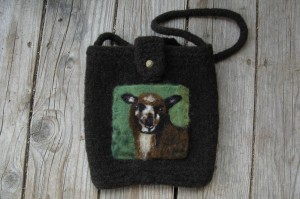 felting the bag were easy. I decided the best memory of the farm would be to have a needle-felt picture of a sheep that I drew myself. The first step was to choose my favorite lamb. Four of them were white. That would make them too difficult and dull for me to needle felt. Two lambs were brown, but one of them looked like a cow. So Dahlia with her fluffy, brown body and white facial markings won. I took a bunch of photos of her and selected one for the picture. I started working on it at the Norway Arts Fair the following weekend as Abbie and I demonstrated needle felting. People strolled by and watched. “That’s very nice,” they’d say. “Is it a dog?” I thought Dahlia looked like an alien monster when I was done. The nice thing about needle felting is that it’s easy to change what you’ve done. You can felt over it or rip it out. Abbie and Marty gave me advice on how to make mine look more like a sheep. As I was putting the finishing touches on Dahlia at the Lewiston Farmers Market, a couple of women looked at my work and remarked, “You’re so talented.” I had to bite my tongue before looking up and saying “Thank you.” Later I noticed Dahlia did look nice when viewed from the customers’ perspective of upside down.
felting the bag were easy. I decided the best memory of the farm would be to have a needle-felt picture of a sheep that I drew myself. The first step was to choose my favorite lamb. Four of them were white. That would make them too difficult and dull for me to needle felt. Two lambs were brown, but one of them looked like a cow. So Dahlia with her fluffy, brown body and white facial markings won. I took a bunch of photos of her and selected one for the picture. I started working on it at the Norway Arts Fair the following weekend as Abbie and I demonstrated needle felting. People strolled by and watched. “That’s very nice,” they’d say. “Is it a dog?” I thought Dahlia looked like an alien monster when I was done. The nice thing about needle felting is that it’s easy to change what you’ve done. You can felt over it or rip it out. Abbie and Marty gave me advice on how to make mine look more like a sheep. As I was putting the finishing touches on Dahlia at the Lewiston Farmers Market, a couple of women looked at my work and remarked, “You’re so talented.” I had to bite my tongue before looking up and saying “Thank you.” Later I noticed Dahlia did look nice when viewed from the customers’ perspective of upside down.
During the week, I helped move the electric fences for rotational grazing. Sheep quickly eat up the vegetation in an area, and moving them to new grass helps keep the number of parasites they ingest from the grass to a low enough level that they don’t get sick. The sheep were moved to a new pasture every day or two. One day after we moved the fence, I noticed Dahlia was sticking her head through the fence to get at the grass on the other side. The fence wasn’t on at the time. However, since lambs don’t understand the fence yet, there is a danger that they will put their head through the fence when it’s on and strangle themselves when they panic and get tangled up in it. We made sure Dahlia’s head was out of the fence when we turned it back on. When I went to bed that night, I thought I heard a sheep baaing. It sort of sounded like Dahlia, and the baas were about ten seconds apart. I fell asleep. The next morning the sheep were next to the cabin where I slept. Since they were right there, I looked around for Dahlia. I saw her sitting at the far side of the fence. Her body seemed to bounce every two seconds. She had gotten herself stuck in the electric fence. I turned it off and hurried back to her. She was sitting there chewing her cud. Mary Ann untangled her neck from the fence and Dahlia wandered off to graze, tipping sideways occasionally as she recovered from the shock.
One of Marty’s favorite activities is dyeing. She has a dye garden where she grows plants like indigo, zinnia and black-eyed susan which are used for natural dyeing. She also uses acid dyes which are manufactured chemical dyes. Like a witch with a caldron, Marty mixed up her dyes in a crock pot and put in the spaghetti-like skeins of yarn. Hours later the yarn had changed to a pastel blue, or a sea foam green, or a rich orange.
During my last week on the farm, I decided to buy enough wool from one of the sheep that I had seen shorn to knit a pair of socks. This meant I had to go through all the steps of processing the wool myself. I chose wool from the gray colored Chamomile. I had washed it previously so I started with carding. That went quickly. Next up was spinning. That took a couple of days and my skills at spinning improved. I plied two of the bobbins of yarn together, wound the finished yarn onto a niddy noddy to make a skein, and twisted the skein into an attractive bundle. The sock knitting will come later.
By the end of my five weeks at A Wrinkle in Thyme Farm, my knitting skills had improved. I’d gone from ripping out a sock that was almost finished because I’d made a mistake I didn’t know how to fix, to picking up dropped stitches and removing the extra ‘stitch’ of a yarn over. I left the farm with a needle felted Dahlia picture on a felted bag, a pair of felted slippers, a pair of socks, yarn I’d made from the fleece of Chamomile, and I left two wine bottle hats as gifts. I also left with the knowledge and appreciation for what it takes to make high quality yarn.

